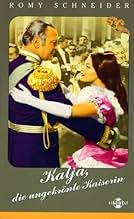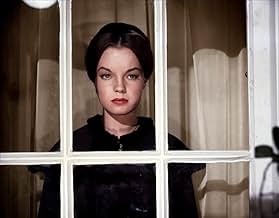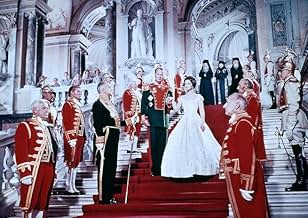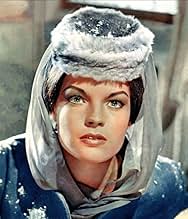IMDb-BEWERTUNG
5,9/10
501
IHRE BEWERTUNG
Zar Alexandre II. trifft eine junge Studentin, Katia. Er versteht, dass er sie liebt und versucht, sie wegzuschicken, aber am Ende sehen sie sich wieder und werden seine Geliebte.Zar Alexandre II. trifft eine junge Studentin, Katia. Er versteht, dass er sie liebt und versucht, sie wegzuschicken, aber am Ende sehen sie sich wieder und werden seine Geliebte.Zar Alexandre II. trifft eine junge Studentin, Katia. Er versteht, dass er sie liebt und versucht, sie wegzuschicken, aber am Ende sehen sie sich wieder und werden seine Geliebte.
Senta Berger
- Une dame de la cour
- (Nicht genannt)
Liliane Chenevière
- Une élève
- (Nicht genannt)
Handlung
WUSSTEST DU SCHON:
- WissenswertesAfter Mädchenjahre einer Königin (1954) and the Sissi-Trilogy this is the 5th time Romy Schneider is playing a real-life monarch as a romanticized version of it in the 1950s.
- PatzerRussian last names are usually declined, especially if they end with "iy" or "ov". They are changed to "aya" and "ova". During the entire movie the male version of the last names are used when addressing or announcing women. So was Katjas last name "Dolgorukova" instead of "Dolgoruki" as said in the movie.
- VerbindungenReferenced in Private School - Die Superanmacher (1983)
Ausgewählte Rezension
Following his 11-year tenure in Hollywood between 1941 and 1952, expatriate German director Siodmak decided to return to Europe; he would subsequently contrive to make three more English-language films, even if they weren’t up to his best work in the States – but, then, neither was the ‘foreign’ stuff.
This costumer (a remake of a 1938 film by Maurice Tourneur) is a German/French co-production: it’s a good-looking if stilted melodrama involving impossible love in the Russian court of Alexander II (Curd Jurgens); with an ailing wife, he draws his amorous attention to a proud teenage beauty (Romy Schneider). Their romance, however, is likely to throw the already troubled Czarist rule (by the activities of a group of terrorists seeking more humane laws) into turmoil; he himself mistrusts his ministers, but they in their turn are willing to collaborate with the ‘enemy’ in order to put a stop to Jurgens and Schneider’s love – which is giving the Empire a bad name thus threatening their own position!
In fact, during the course of the film, we are witness to no fewer than four attempts on the Czar’s life – which is a bit much, if you ask me; nevertheless, it’s in scenes like these where we get a glimpse of the old Siodmak (he was one of the finest exponents of Film Noir): the film’s most creative bit of direction is Siodmak’s decision to refrain from showing a duel but rather concentrate on the snow-covered trees nearby and only cutting to the bloodied body (Katia’s officer brother who was defending her honor!) once the shots are heard on the soundtrack. The revolutionaries themselves – led by future Claude Chabrol regular Michel Bouquet – are typically depicted as desperate men (and women) rather than villainous (a fate reserved for the Ministers, though they’re actually more pitiful and misguided in their own self-importance than truly evil); the ultimate irony is that Jurgens had always been sympathetic to the terrorists’ cause, but the burden of tradition and a whole set of events (such as the release of the rebels’ imprisoned friends, promised them by the Emperor via Katia, seen as an act of betrayal when the Ministers arrange for the ex-convicts to be gunned down soon after) eventually seal his fate…just as, with the Empress dead, Schneider was about to take her place on the throne by his side!
For the record, the impossibly young Schneider had actually risen to stardom with a similar Ruritanian i.e. quasi fairy-tale role – that of Princess Sissi in a series of three Austrian films made between 1955 and 1957; as for Jurgens, I have his second of two Michel Strogoff films (made in 1956 and 1961) recorded, as was this one, off Italian TV awaiting its turn to be watched. Finally, given KATIA’s silly U.S. retitling, one shouldn’t confuse it with an earlier Siodmak picture from his Hollywood days – THE GREAT SINNER (1949) which, incidentally, was also a period piece about Russians (adapted, as a matter of fact, from Fyodor Dostoyevsky’s “The Gambler”).
This costumer (a remake of a 1938 film by Maurice Tourneur) is a German/French co-production: it’s a good-looking if stilted melodrama involving impossible love in the Russian court of Alexander II (Curd Jurgens); with an ailing wife, he draws his amorous attention to a proud teenage beauty (Romy Schneider). Their romance, however, is likely to throw the already troubled Czarist rule (by the activities of a group of terrorists seeking more humane laws) into turmoil; he himself mistrusts his ministers, but they in their turn are willing to collaborate with the ‘enemy’ in order to put a stop to Jurgens and Schneider’s love – which is giving the Empire a bad name thus threatening their own position!
In fact, during the course of the film, we are witness to no fewer than four attempts on the Czar’s life – which is a bit much, if you ask me; nevertheless, it’s in scenes like these where we get a glimpse of the old Siodmak (he was one of the finest exponents of Film Noir): the film’s most creative bit of direction is Siodmak’s decision to refrain from showing a duel but rather concentrate on the snow-covered trees nearby and only cutting to the bloodied body (Katia’s officer brother who was defending her honor!) once the shots are heard on the soundtrack. The revolutionaries themselves – led by future Claude Chabrol regular Michel Bouquet – are typically depicted as desperate men (and women) rather than villainous (a fate reserved for the Ministers, though they’re actually more pitiful and misguided in their own self-importance than truly evil); the ultimate irony is that Jurgens had always been sympathetic to the terrorists’ cause, but the burden of tradition and a whole set of events (such as the release of the rebels’ imprisoned friends, promised them by the Emperor via Katia, seen as an act of betrayal when the Ministers arrange for the ex-convicts to be gunned down soon after) eventually seal his fate…just as, with the Empress dead, Schneider was about to take her place on the throne by his side!
For the record, the impossibly young Schneider had actually risen to stardom with a similar Ruritanian i.e. quasi fairy-tale role – that of Princess Sissi in a series of three Austrian films made between 1955 and 1957; as for Jurgens, I have his second of two Michel Strogoff films (made in 1956 and 1961) recorded, as was this one, off Italian TV awaiting its turn to be watched. Finally, given KATIA’s silly U.S. retitling, one shouldn’t confuse it with an earlier Siodmak picture from his Hollywood days – THE GREAT SINNER (1949) which, incidentally, was also a period piece about Russians (adapted, as a matter of fact, from Fyodor Dostoyevsky’s “The Gambler”).
- Bunuel1976
- 9. Juli 2008
- Permalink
Top-Auswahl
Melde dich zum Bewerten an und greife auf die Watchlist für personalisierte Empfehlungen zu.
Details
- Erscheinungsdatum
- Herkunftsland
- Offizieller Standort
- Sprache
- Auch bekannt als
- Adorable Sinner
- Drehorte
- Produktionsfirma
- Weitere beteiligte Unternehmen bei IMDbPro anzeigen
- Laufzeit1 Stunde 31 Minuten
- Sound-Mix
Zu dieser Seite beitragen
Bearbeitung vorschlagen oder fehlenden Inhalt hinzufügen

Oberste Lücke
By what name was Katja, die ungekrönte Kaiserin (1959) officially released in India in English?
Antwort































